Rise of Wearable Technology
The wearable technology sector is experiencing rapid growth in Spain, which is significantly influencing the ultra low-power-microcontroller market. With an increasing number of consumers adopting fitness trackers, smartwatches, and health monitoring devices, the demand for microcontrollers that offer low power consumption is paramount. The wearable technology market is anticipated to expand by 18% over the next five years, creating a substantial demand for ultra low-power microcontrollers. These devices require microcontrollers that can operate efficiently while maintaining long battery life, thus driving innovation in the market. Additionally, the integration of health-related features in wearables necessitates advanced microcontroller capabilities, further propelling the growth of the ultra low-power-microcontroller market. This trend indicates a promising future for manufacturers focusing on developing specialized microcontrollers for the wearable technology sector.
Growing Adoption of Smart Devices
The increasing integration of smart devices in various sectors is driving the ultra low-power-microcontroller market. In Spain, the proliferation of smart home technologies, wearables, and industrial automation systems necessitates microcontrollers that consume minimal power while delivering high performance. The demand for energy-efficient solutions is evident, with a projected growth rate of 15% in the smart device sector over the next five years. This trend indicates a robust market for ultra low-power microcontrollers, as manufacturers seek to enhance battery life and reduce energy consumption. Furthermore, the Spanish government is promoting smart city initiatives, which further fuels the need for advanced microcontroller technologies. As a result, the ultra low-power-microcontroller market is poised for significant expansion, driven by the growing adoption of smart devices across various applications.
Increased Focus on Sustainability
Sustainability has become a pivotal concern in Spain, influencing the ultra low-power-microcontroller market. As industries strive to reduce their carbon footprint, the demand for energy-efficient microcontrollers is on the rise. Companies are increasingly adopting eco-friendly practices, which include utilizing ultra low-power microcontrollers in their products. This shift is supported by government regulations aimed at promoting sustainable technologies, potentially leading to a market growth of 20% in the next few years. The emphasis on reducing energy consumption aligns with the broader goals of achieving environmental sustainability. Consequently, manufacturers are investing in research and development to create microcontrollers that not only meet performance standards but also adhere to sustainability criteria. This trend is likely to enhance the competitive landscape of the ultra low-power-microcontroller market.
Expansion of Automotive Electronics
The automotive sector in Spain is undergoing a transformation, with a notable shift towards electric and hybrid vehicles. This transition is significantly impacting the ultra low-power-microcontroller market. As vehicles become more reliant on electronic systems for functionalities such as battery management, infotainment, and safety features, the demand for ultra low-power microcontrollers is expected to surge. The automotive electronics market is projected to grow by 12% annually, indicating a substantial opportunity for microcontroller manufacturers. Furthermore, the integration of advanced driver-assistance systems (ADAS) necessitates the use of energy-efficient microcontrollers to optimize performance without compromising battery life. This trend suggests that the ultra low-power-microcontroller market will play a crucial role in supporting the evolving automotive landscape in Spain.
Technological Advancements in Communication Protocols
The evolution of communication protocols is reshaping the ultra low-power-microcontroller market in Spain. As industries increasingly adopt wireless communication technologies, the need for microcontrollers that support various protocols, such as Bluetooth Low Energy (BLE) and Zigbee, is growing. These advancements enable devices to communicate efficiently while consuming minimal power, which is crucial for battery-operated applications. The market for wireless communication is projected to grow by 25% in the coming years, indicating a strong demand for ultra low-power microcontrollers that can facilitate these technologies. Furthermore, the integration of advanced communication features in consumer electronics and industrial applications is likely to enhance the functionality of devices, thereby driving the ultra low-power-microcontroller market. This trend suggests that manufacturers must focus on developing microcontrollers that are compatible with emerging communication standards.























Leave a Comment